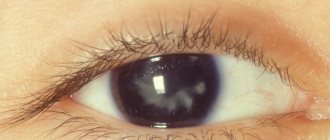What is color
Color is the subjective perception by the human brain of visible light, the differences in its spectral structure perceived by the eye. Humans have a better ability to distinguish colors than other mammals.
Light affects the photosensitive receptors in the retina, which then produce a signal that is transmitted to the brain. It turns out that the perception of color is formed in a complex way in the chain: the eye (neural networks of the retina and exteroceptors) – visual images of the brain.
Thus, color is an interpretation of the surrounding world in the human mind, arising as a result of processing signals coming from the light-sensitive cells of the eye - cones and rods. In this case, the former are responsible for the perception of color, and the latter are responsible for the acuity of twilight vision.
How does color perception work?
In the central part of the retina of the eye there are special receptors - cones. There are 3 of them and each has a special type of light-sensitive pigment; they are responsible for the difference between red, green and blue colors. In people without pathology, all 3 pigments are located in cones, so they have the ability to detect many tones.
In the cones of a colorblind person, one can find the absence of one or more pigments or the pigment in much smaller quantities, which is why problems arise with the difference and perception of colors.
"Color Disorders"
The eye reacts to three primary tones: blue, green and red. And the brain perceives colors as a combination of these three primary colors. If the retina loses the ability to distinguish any color, then the person also loses it. For example, there are people who are unable to distinguish green from red. 7% of men and 0.5% of women have such features. It is extremely rare that people do not see colors around them at all, which means that the receptor cells in their retina do not function. Some suffer from weak twilight vision - this means that they have weakly sensitive rods. Such problems arise for various reasons: due to vitamin A deficiency or hereditary factors. However, a person can adapt to “color disorders”, so without special examination they are almost impossible to detect. People with normal vision are able to distinguish up to a thousand shades. A person's perception of color changes depending on the conditions of the surrounding world. The same tone looks different under candlelight or sunlight. But human vision quickly adapts to these changes and identifies the familiar color.
Causes of color blindness
There are 2 types of disease:
- Genetic color blindness develops after the transfer of the X chromosome from the carrier of the gene to the child. Women act as carriers of the gene, and boys most often receive this gene. In the female half of the population, the damaged gene can be compensated by the second chromosome (from the XX set). In turn, men have a different set of chromosomes - XY, so the gene cannot be compensated, therefore, impaired color perception is more often recorded in males.
- Acquired color blindness is a vision feature acquired during life. As a rule, the development of the disease is preceded by damage to the retina or optic nerve. Acquired color blindness is characterized by a constant deterioration of the condition.
Acquired color blindness occurs due to:
- age;
- taking medications;
- injury that damages the retina or optic nerve.
Shape perception
Exploring nature, man constantly discovered new principles of the structure of the world - symmetry, rhythm, contrast, proportions. He was guided by these impressions, transforming the environment, creating his own unique world. Subsequently, the objects of reality gave rise to stable images in the human mind, accompanied by clear emotions. The individual’s perception of shape, size, and color is associated with the symbolic associative meanings of geometric figures and lines. For example, in the absence of divisions, the vertical is perceived by a person as something infinite, incommensurable, upward, light. A thickening at the bottom or a horizontal base makes it more stable in the eyes of the individual. But the diagonal symbolizes movement and dynamics. It turns out that a composition based on clear verticals and horizontals tends toward solemnity, staticity, and stability, while an image based on diagonals tends toward variability, instability, and movement.
Double Impact
It is a generally accepted fact that the perception of color is accompanied by a strong emotional impact. This problem was studied in detail by painters. V. V. Kandinsky noted that color affects a person in two ways. First, the individual experiences a physical effect when the eye is either fascinated by the color or irritated by it. This impression is fleeting when it comes to familiar objects. However, in an unusual context (an artist’s painting, for example), color can evoke a strong emotional experience. In this case, we can talk about the second type of influence of color on an individual.
Physical effects of color
Numerous experiments by psychologists and physiologists confirm the ability of color to influence a person’s physical condition. Dr. Podolsky described human visual perception of color as follows.
- Blue color - has an antiseptic effect. It is useful to look at it during suppuration and inflammation. For a sensitive individual, a blue tint helps better than green. But an “overdose” of this color causes some depression and fatigue.
- Green color is hypnotic and analgesic. It has a positive effect on the nervous system, relieves irritability, fatigue and insomnia, and also improves tone and lowers blood pressure.
- Yellow color stimulates the brain, therefore helps with mental deficiency.
- Orange color - has a stimulating effect and speeds up the pulse without raising blood pressure. It improves your mood, raises your vitality, but over time it can tire you.
- Violet color - affects the lungs, blood vessels, heart and increases the endurance of body tissues.
- Red color has a warming effect. It stimulates brain activity, eliminates melancholy, but in large doses it is irritating.
Types of colors
The influence of color on perception can be classified in different ways. There is a theory according to which all tones can be divided into stimulating (warm), disintegrating (cold), pastel, static, dull, warm dark and cold dark.
Stimulating (warm) colors promote arousal and act as irritants:
- red – life-affirming, strong-willed;
- orange – cozy, warm;
- yellow – radiant, contacting.
Disintegrating (cold) tones dampen excitement:
- purple – heavy, in-depth;
- blue - emphasizing distance;
- light blue - guide, leading into space;
- blue-green – changeable, emphasizing movement.
Pastel colors mute the impact of pure colors:
- pink – mysterious and delicate;
- purple – isolated and closed;
- pastel green – soft, affectionate;
- gray-blue – reserved.
Static colors can balance and distract from exciting colors:
- pure green – refreshing, demanding;
- olive – softening, soothing;
- yellow-green – liberating, renewing;
- purple – pretentious, sophisticated.
Deep tones promote concentration (black); do not cause excitement (gray); extinguish irritation (white).
Warm dark colors (brown) cause lethargy and inertia:
- ocher – softens the growth of excitement;
- earthy brown – stabilizes;
- dark brown – reduces excitability.
Dark, cool tones (black-blue, dark gray, green-blue) suppress and isolate irritation.
Color and personality
The perception of color largely depends on the personal characteristics of a person. This fact was proven in his works on the individual perception of color compositions by the German psychologist M. Luscher. According to his theory, an individual in a different emotional and mental state can react differently to the same color. Moreover, the characteristics of color perception depend on the degree of personality development. But even with weak mental sensitivity, the colors of the surrounding reality are perceived ambiguously. Warm and light colors attract the eye more than dark ones. And at the same time, clear but poisonous colors cause anxiety, and a person’s vision involuntarily looks for a cold green or blue tint to rest.
Treatment
Genetic color blindness cannot be cured, however, I would like to note that in 2009, notes appeared about a successful test in the field of genetic engineering. The experiment consisted of introducing the X chromosome into monkeys. The scientists who conducted the experiment declared a successful completion.
Color perception disorders may be treatable if color blindness was acquired during life. The one that is acquired as a result of injury or the development of cataracts can be treated. Treatment is carried out through surgery.
Although the treatment of genetic color blindness is considered impossible today, research in this area did not end only with the experiments of American scientists. Today there is a method for correcting the disease - specialized glasses EnChroma. They partially remove some color waves between hard-to-see parts of the spectrum, widening the gap between them. This allows a colorblind person to see the world in its true color.
Useful video
All about color blindness:
Color in advertising
In an advertising message, the choice of color cannot depend only on the taste of the designer. After all, bright colors can both attract the attention of a potential client and make it difficult to obtain the necessary information. Therefore, the perception of an individual’s shape and color must be taken into account when creating advertising. Solutions can be the most unexpected: for example, against a motley background of bright pictures, a person’s involuntary attention is more likely to be attracted by a strict black and white ad rather than a colorful inscription.
Diagnostics
First, if color blindness is suspected, the patient consults a doctor who conducts a survey and examination. During the examination, the doctor will first ask about possible heredity.
For a more thorough study of color blindness, doctors use specially developed polychromatic Rabkin tables. The set includes 27 multi-colored cards with images on them. The card itself is filled with circles and dots of various diameters, which have the same brightness, but differ in halftones and even colors. Geometric figures or numbers are veiled among the multi-colored dots.
If the patient does not recognize the images in the picture, then he is diagnosed with color blindness. A person without vision pathologies (trichromat) will see numbers and geometric shapes in the images.
Children and colors
Children's perception of color develops gradually. At first, they only recognize warm colors: red, orange and yellow. Then the development of mental reactions leads to the fact that the child begins to perceive blue, violet, indigo and green. And only with age does the baby become available to all the variety of color tones and shades. At three years old, children, as a rule, name two or three colors, and recognize about five. Moreover, some children have difficulty distinguishing basic tones even at the age of four. They poorly differentiate colors, have difficulty remembering their names, replace intermediate shades of the spectrum with the main ones, and so on. In order for a child to learn to adequately perceive the world around him, he needs to be taught to correctly distinguish colors.
Types of color blindness
There is a misconception that colorblind people are completely unable to identify colors. This opinion is wrong. Most often, the disease is characterized by a violation of the perception of one or two colors; there are also color blind people who distinguish all colors, but have difficulty identifying shades. The rarest type are people who cannot distinguish colors at all.
Achromasia and monochromasia
A feature in which a person is diagnosed with an absolute lack of color vision.
This feature is observed very rarely, namely 0.1% of the entire population.
With achromasia, light waves, regardless of their length, are defined as different shades of gray.
Development of color perception
Color perception should be taught from a very early age. The baby is naturally very inquisitive and needs a variety of information, but it must be introduced gradually so as not to irritate the child’s sensitive psyche. At an early age, children usually associate color with the image of an object. For example, green is a Christmas tree, yellow is a chicken, blue is the sky, and so on. The teacher needs to take advantage of this moment and develop color perception using natural forms.
Color, unlike size and shape, can only be seen. Therefore, when determining tone, a large role is played by comparison by superposition. If two colors are placed side by side, every child will understand whether they are the same or different. At the same time, he does not yet need to know the name of the color; it is enough to be able to complete tasks like “Plant each butterfly on a flower of the same color.” After the child learns to visually distinguish and compare colors, it makes sense to begin choosing according to the pattern, that is, to actually develop color perception. To do this, you can use the book by G. S. Shvaiko entitled “Games and game exercises for speech development.” Getting to know the colors of the world around us helps children feel reality more subtly and more fully, develops thinking and observation, and enriches speech.
What is color blindness
This is an official disease from the field of ophthalmology, which is characterized by the inability of vision to distinguish certain shades . Most often, it is hereditary color blindness that occurs, but doctors do not exclude the possibility of developing the disease.
This type of vision defect is very difficult to treat normally, so the patient continues to be unable to perceive the colors around him for the rest of his life. The disease is easily diagnosed in childhood, so all caring parents are obliged to promptly contact a treating specialist for consultation.
How a colorblind person perceives the world
In images on the Internet, you can see that colorblind people have real problems with the perception of the red hue, and with overall saturation. Regarding the yellow color, deviations from the general standard are also visible. Features of the appearance of the surrounding world will directly depend on the color that patients perceive incorrectly . For example, patients with protanopia have a defect in the perception of the red tint and all its colors, and patients with tritanopia have difficulties with the perception of blue and yellow tints. How a colorblind person sees will directly depend on the type of development of the disease.
What colors do colorblind people see?
Such abnormal processes in people are quite rare; for example, complete color blindness and non-perception of surrounding colors in the world prevail in only 0.1 percent of all clinical cases. In other situations, the colorblind person continues to perceive colors in his own way and also sees color pictures. In modern ophthalmology, there are common disorders that describe one or another form of color blindness :
- During protanopia, a patient of any age confuses red with brown, black, brown, green, and brown.
- During developed deuteranomaly, certain difficulties occur with the perception of the color green; it is very often confused with orange and also red.
- During tritanopia, violet disappears from the usual perception of color correction; patients in this case are unable to normally perceive blue.
What colors are not distinguishable
Color blindness is diagnosed by a doctor based on a specific clinical picture with numbers in the form of colored circles. The world around such people does not change its shape, but changes its shade and appearance. The patient himself does not notice such anomalies around himself; his close relatives and friends are able to sound the alarm. Failure to distinguish primary colors can be called not only color blindness, but also color blindness. In this case, the essence of the matter does not change - the inability to normally distinguish surrounding colors remains in place. Colorblind people are no different from people with normal color references, but they have their own characteristics.
Visual color
One British resident, Neil Harbisson, conducted an interesting experiment on himself. Since childhood, he could not distinguish colors. Doctors found that he had a rare vision defect - achromatopsia. The guy saw the surrounding reality as if in a black and white movie and considered himself a socially cut-off person. One day, Neil agreed to an experiment and allowed a special cybernetic instrument to be implanted into his head, which allows him to see the world in all its colorful diversity. It turns out that the eye's perception of color is not at all necessary. A chip and antenna with a sensor were implanted in the back of Neil's head, which picks up vibration and converts it into sound. In this case, each note corresponds to a specific color: F - red, A - green, Do - blue, and so on. Now for Harbisson, a visit to the supermarket is akin to visiting a nightclub, and an art gallery reminds him of a trip to the Philharmonic. Technology gave Neil a sensation never before seen in nature: visual sound. The man makes interesting experiments with his new feeling, for example, coming close to different people, studying their faces and composing music for portraits.
Another optical provocation: are the sneakers gray or pink?
The slipper puzzled me with its color: it is not what it seems.
The Russian segment of the Internet again fell for optical provocation. Users of social networks “share” a photo of either a sneaker or sneakers, asking each other what color it is. Gray-green or white-pink? They suggest you take a closer look - in the first case, the sneaker has a gray top, green sole and laces, in the second - the top is pink, and the sole and laces are white.
The “dress of discord” was replaced by the controversial slipper - simple, but mysterious.
People dreamed of different things - one of the above. This divided them into two irreconcilable camps. Much like the last time, when millions of Internet users argued about what color a striped dress was. Because they also saw different things - either golden with white stripes, or black with blue. The phenomenon was incredibly popular. It even got its own name - dressgate.
The slipper is, of course, far from the dress - there is not so much debate about it. But the number of people who want to know what color the sneakers really are is multiplying.
The secret of the dress was revealed back in 2015, shortly after it became controversial on the Internet. In the photo, originally published from the social network Tumblr, users eventually recognized the lace dress from Roman Originals. It's blue-black.
Neurophysiologists and ophthalmologists explained why the dress appears white and gold to some. The point is people's ability to perceive certain colors. It depends on the light-sensitive receptors of the retina - cones, which we were taught about at school. Some react to red, others to green, and others to blue.
If all cones function with approximately the same strength, then a person can equally clearly distinguish all the colors of the spectrum. But this almost never happens in real life - some cones are more, some are less. And this changes the perception, making it individual. Those who “lose” the blue color have few blue cones. In addition, the background on which the object is located influences how we perceive color. And lighting. Against a bright background and in poor lighting, blue can appear white and black can appear golden.
The dress is the same, but people saw it differently.
Dress of Discord in the store: it's blue and black.
What about the slipper? About the same. Only with other colors. Experts claim that here, too, the illusion of a “color change” occurs against a dark background. And it is enhanced by the flash with which the photo was taken.
By the way, the real color of the sneaker appears if you examine the picture on a computer screen, looking at it slightly from above. The sneaker turns pink, and the laces and sole turn white. That's how he really is.
Following in the footsteps of an old sneaker
The “shoe illusion” appeared back in 2021. It was “launched” by a certain Nicole Coulthard, unaware of the effect her post, published in the Girlsmouth group on Facebook, would have. As the British newspaper Metro found out, the post was preceded by an interesting story.
A friend bought sneakers for Nicole as a gift. I sent a photo to Nicole's mother. She replied that the sneakers were good and the color was right - they say, gray “befits” Nicole. A friend, in turn, wrote that the sneakers were pink. But looking at the picture again, I saw that they were gray. Sent a photo from Nicole. Like, look, what a miracle. She answered: don’t make me laugh, the sneakers are pink. The friends almost had a fight. Nicole was reproached for simply knowing the real color of the sneakers. But in the photo they still look gray. In a word, saying that they were pink, Nicole mocked her friend.
Thirsty for justice, Nicole posted the photo on social media with a request to write who sees what color. Most saw gray and green.
The controversial sneakers are from the American company Vans. They are actually pink. This is clearly visible in a photo taken in normal lighting. And in the photo taken with a flash, even her friend’s pink finger, which was included in the frame, turned green. Optical illusion, you know...
Slippers of real (left) color and optically deceptive.
The “shoe illusion” appeared on the Russian segment of the Internet for the second time - in early May of this year, at the instigation of a certain Saudat Salami. I came with an addition: supposedly the color of the sneaker depends on which hemisphere is more developed in a person. People fell for it: it’s both entertainment and a simple way to determine the dominance of one hemisphere or another in one’s own brain. The post was noticed by curious people and put into circulation again. And again very successfully - with an abundance of likes. And the disputes resumed. Although what was happening was clear 2 years ago.
The post that sent the sneaker into Internet orbit for the second time.
Our people welcomed the return of the slipper. And they contributed to this.










